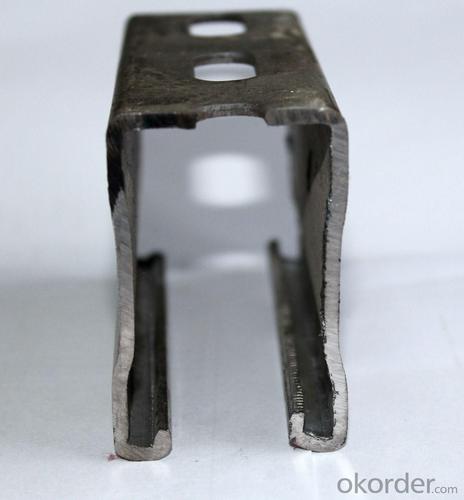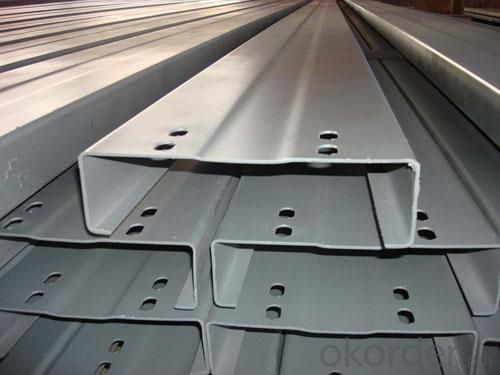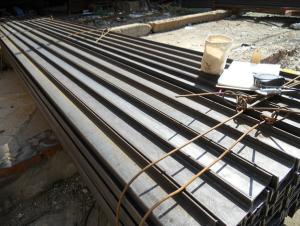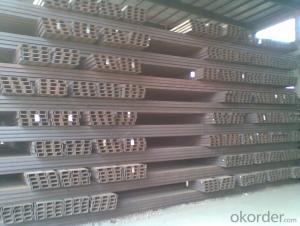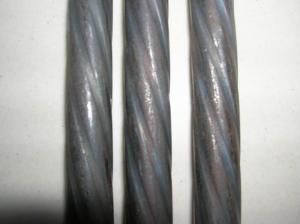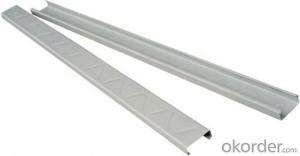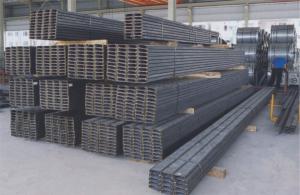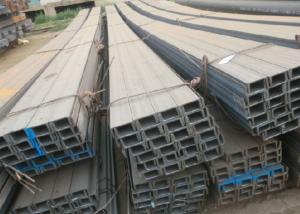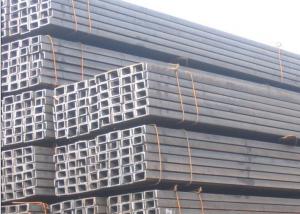MS C Channel Bar
- Loading Port:
- Tianjin Port,China
- Payment Terms:
- TT or LC
- Min Order Qty:
- 20Tons m.t.
- Supply Capability:
- 1000 Tons Per Month m.t./month
OKorder Service Pledge
OKorder Financial Service
You Might Also Like
Specifications of MS C Channel Bar:
1.We supply high quality MS C Channel Bar at reasonable price, including Chinese standard, Japanese standard and so on.
Standard | GB/JIS/EN/ASTM/DIN |
Material Grade | Q235B,Q235,Q345,Q345B,SS400,S235JRG1,A36,ST37-2 |
Technique: | Cold Rolled |
Sizes as per chinese standard: |
80×40×20×2.5 - 180×60×20×2.5
|
Sizes as per Japanese standard: |
180×60×20×3 – 300×80×20×3 |
Length: | 6meter, 9meter, 12meter |
Note: we are also competent to provide our customers other MS C Channel Bar based on other sizes according to customer’s requirements.
2. The detailed sections of MS C Channel Bar as per GB standard.Just as followings in the table-1:
Size | Weight(kg/m) | Size | Weight(kg/m) |
80×40×20×2.5 | 3.925 | 180×60×20×3 | 8.007 |
80×40×20×3 | 4.71 | 180×70×20×2.5 | 7.065 |
100×50×20×2.5 | 4.71 | 180×70×20×3 | 8.478 |
100×50×20×3 | 5.652 | 200×50×20×2.5 | 6.673 |
120×50×20×2.5 | 5.103 | 200×50×20×3 | 8.007 |
120×50×20×3 | 6.123 | 200×60×20×2.5 | 7.065 |
120×60×20×2.5 | 5.495 | 200×60×20×3 | 8.478 |
120×60×20×3 | 6.594 | 200×70×20×2.5 | 7.458 |
120×70×20×2.5 | 5.888 | 200×70×20×3 | 8.949 |
120×70×20×3 | 7.065 | 220×60×20×2.5 | 7.4567 |
140×50×20×2.5 | 5.495 | 220×60×20×3 | 8.949 |
140×50×20×3 | 6.594 | 220×70×20×2.5 | 7.85 |
160×50×20×2.5 | 5.888 | 220×70×20×3 | 9.42 |
160×50×20×3 | 7.065 | 250×75×20×2.5 | 8.634 |
160×60×20×2.5 | 6.28 | 250×75×20×3 | 10.362 |
160×60×20×3 | 7.536 | 280×80×20×2.5 | 9.42 |
160×70×20×2.5 | 6.673 | 280×80×20×3 | 11.304 |
160×70×20×3 | 8.007 | 300×80×20×2.5 | 9.813 |
180×50×20×2.5 | 6.28 | 300×80×20×3 | 11.775 |
180×50×20×3 | 7.536 | ||
180×60×20×2.5 | 6.673 |
Table-1
3. The chemical composition of MS C Channel Bar according to Q235B is shown in Table-2.
Alloy No | Grade | Element(%) | ||||
C | Mn | S | P | Si | ||
Q235 | B | 0.12-0.20 | 0.3-0.7 | ≦0.045 | ≦0.045 | ≦0.3 |
Table-2
Note: we are able to present our customers relevant SGS test report for chemical composition of MS C Channel Bar.
4. The mechanical property of MS C Channel Bar according to Q235B is shown in Table-3-1 and Table-3-2
Alloy No | Grade | Yielding Strength Point(Mpa) | |||
Thickness(mm) | |||||
≦16 | >16-40 | >40-60 | >60-100 | ||
≧ | |||||
Q235 | B | 235 | 225 | 215 | 205 |
Table-3-1
Alloy No | Grade | Tensile Strength(Mpa) | Elongation After Fracture(%) | |||
Thickness(mm) | ||||||
≦16 | >16-40 | >40-60 | >60-100 | |||
≧ | ||||||
G235 | B | 375-500 | 26 | 25 | 24 | 23 |
Table-3-2
Note: we are able to present our customers relevant SGS test report for mechanical property of MS C Channel Bar as customer’s request.
Applications of MS C Channel Bar:
The MS C Channel Bar can be applied to construction of warehouses, workshops, sport stadiums and car parks etc.The hot rolled channel steel belongs to carbon structural steel which is applied to in the field of construction and machinery.In details, the hot rolled channel steel is usually used for arch-itechtural structure, and they could be welded in order to support or hang a vari-ety of facilities. They are also usually used in combination with I beam. Generally,the hot rolled channel steel we supply must possess perfect welding property, riveting property and mechanical property and so on.
Package & Delivery of MS C Channel Bar:
1.The hot rolled channel steel will be packed in bundle with steel wire at each end of every bundle and color marking in order to help the customer to recognize his goods more easily at sight.
2. And the hot rolled channel steel could be loaded into 20ft or 40ft container, or by bulk cargo.If the weight of each bundle reaches more than 3.5 mt, the loading by break bulk cargo should be choosed.When the weight of each bundle reaches less than 3mt, the loading by container should be choosed.
3.As for the transportaion from mill to loading port, the truck will be usually used. And the maximum quantity for each truck is 40mt.
4.All in all, we could do in accordance with customer's request.
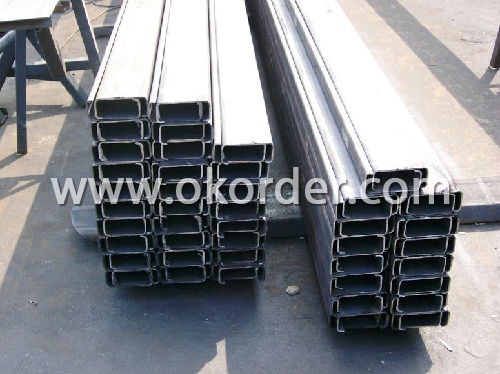
Production Flow of MS C Channel Bar:
1.The steel billet shall be heated in the high temperature furnace.
2. The heated steel billet shall be rolled five to nine times with the aim of shaping the general figure of steel u channel.
3. The hot rolled channel steel should be put onto the cooling bed to make the temperature low.
4. The channel steel should be straighted on the straightener.
5. The straighted channel steel will be cut into meters by saw, as per customer's requirements.
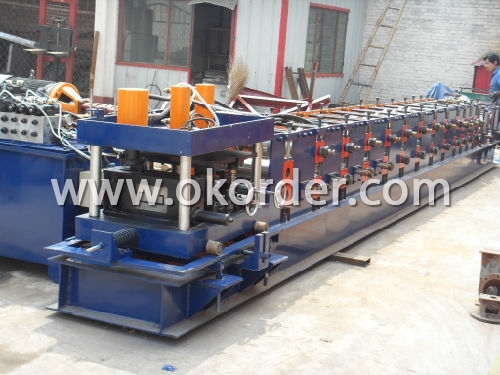
- Q: Channel 10 is calculated, if the price per metre is calculated
- No. 10 channel steel is calculated, that is to say, the standard weight, that is, all channel sizes have reached the standard, our national standard No. 10 channel steel theoretical weight is 10.007 kg / meter.
- Q: How do steel channels contribute to the overall strength of a building?
- Steel channels contribute to the overall strength of a building in several ways. Firstly, steel channels provide structural support by distributing the load evenly across the building's framework. This helps to prevent the building from collapsing under its own weight or external forces such as wind or earthquakes. Secondly, steel channels are often used in the construction of walls, floors, and roofs to provide reinforcement and increase the rigidity of the building. By adding steel channels to these structural elements, the overall strength and stability of the building are enhanced, reducing the risk of structural failure. Furthermore, steel channels can be used as lintels or beams to support heavy loads, such as in bridges or multi-story buildings. Their high strength-to-weight ratio makes them ideal for such applications, as they can withstand significant amounts of load without deforming or failing. Additionally, steel channels contribute to the overall strength of a building by enhancing its resistance to fire and heat. Steel has a high melting point, which means that it can withstand high temperatures for longer periods compared to other building materials. This property helps to prevent structural collapse during a fire, giving occupants more time to evacuate and firefighters more time to control the blaze. In summary, steel channels play a vital role in enhancing the overall strength of a building by providing structural support, reinforcement, load distribution, and fire resistance. Their versatility and high strength-to-weight ratio make them an essential component in modern construction, ensuring the durability and safety of buildings.
- Q: Is the channel 20 the same as the channel 20b?
- No, channel 20, a and B two.20A specifications are: 200*73*7.0, weight per meter is 22.637kg20b specifications are: 200*75*9.0, weight per meter is 25.777kg
- Q: How do steel channels compare to other building materials?
- Steel channels are highly regarded in the construction industry due to their exceptional strength, durability, and versatility. Compared to other building materials like wood or concrete, steel channels offer superior resistance to fire, corrosion, and pests. They also have a higher load-bearing capacity, allowing for greater design flexibility and the ability to construct larger and more complex structures. Additionally, steel channels are known for their consistency in quality and precision, making them a preferred choice for many builders and architects.
- Q: Can steel channels be used for staircases?
- Yes, steel channels can be used for staircases. Steel channels are often used as stringers, which are the structural supports for stairs. They provide strength, durability, and stability to the staircase, making them a popular choice in modern architectural designs.
- Q: Can steel channels be used for structural support?
- Indeed, structural support can be achieved by utilizing steel channels. In the realm of construction, steel channels are frequently employed due to their ability to offer robustness and longevity. Buildings, bridges, and other structures often utilize steel channels to ensure stability and support. These channels are engineered to distribute weight and load evenly, making them an optimal choice for structural support. Moreover, their versatility enables them to be tailored to meet specific design criteria with ease. Ultimately, steel channels are a dependable and efficient option for providing structural support in diverse construction endeavors.
- Q: What are the weight and load-bearing capacities of steel channels?
- The weight and load-bearing capacities of steel channels vary depending on their dimensions and specifications. It is essential to refer to engineering tables or consult with a structural engineer to determine the exact weight and load-bearing capacities for a specific steel channel.
- Q: Larry Midas in seeking to inform how to model such as: steel, double steel, double channel
- If civil is set in the channel, double cross section library inside, Larry is through the section properties of I-steel calculator, drawing DXF graphics in CAD, import
- Q: What are the different types of corrosion protection for steel channels?
- There are several types of corrosion protection methods for steel channels, including galvanizing, painting, powder coating, and applying corrosion-resistant coatings.
- Q: What are the different load capacities of steel channels?
- The load capacities of steel channels can vary depending on factors such as the size and shape of the channel, the type of steel used, and the specific application or design requirements. Generally, steel channels can have load capacities ranging from a few hundred pounds to several thousand pounds. It is important to consult engineering specifications or consult with a structural engineer to determine the exact load capacity of a specific steel channel for a particular application.
1. Manufacturer Overview
| Location | Tianjin,China |
| Year Established | 2006 |
| Annual Output Value | Above US$ 500 Million |
| Main Markets | China; Middle East; Southeast Asia; South America |
| Company Certifications |
2. Manufacturer Certificates
| a) Certification Name | |
| Range | |
| Reference | |
| Validity Period |
3. Manufacturer Capability
| a) Trade Capacity | |
| Nearest Port | Tianjin |
| Export Percentage | 40%-60% |
| No.of Employees in Trade Department | 11-20 People |
| Language Spoken: | English; Chinese |
| b) Factory Information | |
| Factory Size: | Above 50,000 square meters |
| No. of Production Lines | Above 3 |
| Contract Manufacturing | materials for processing; OEM Service Offered |
| Product Price Range | Average |
Send your message to us
MS C Channel Bar
- Loading Port:
- Tianjin Port,China
- Payment Terms:
- TT or LC
- Min Order Qty:
- 20Tons m.t.
- Supply Capability:
- 1000 Tons Per Month m.t./month
OKorder Service Pledge
OKorder Financial Service
Similar products
Hot products
Hot Searches
Related keywords



